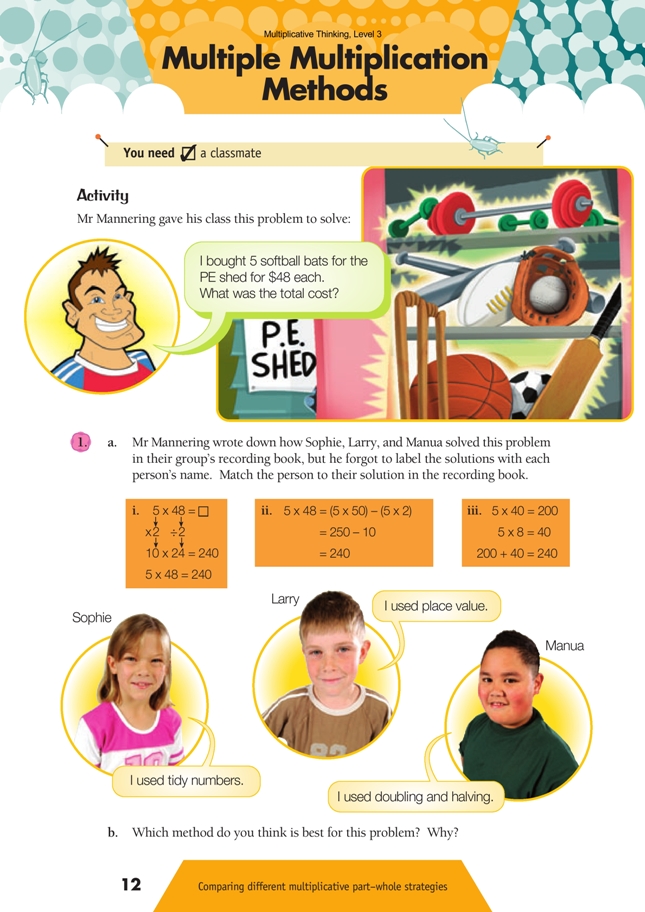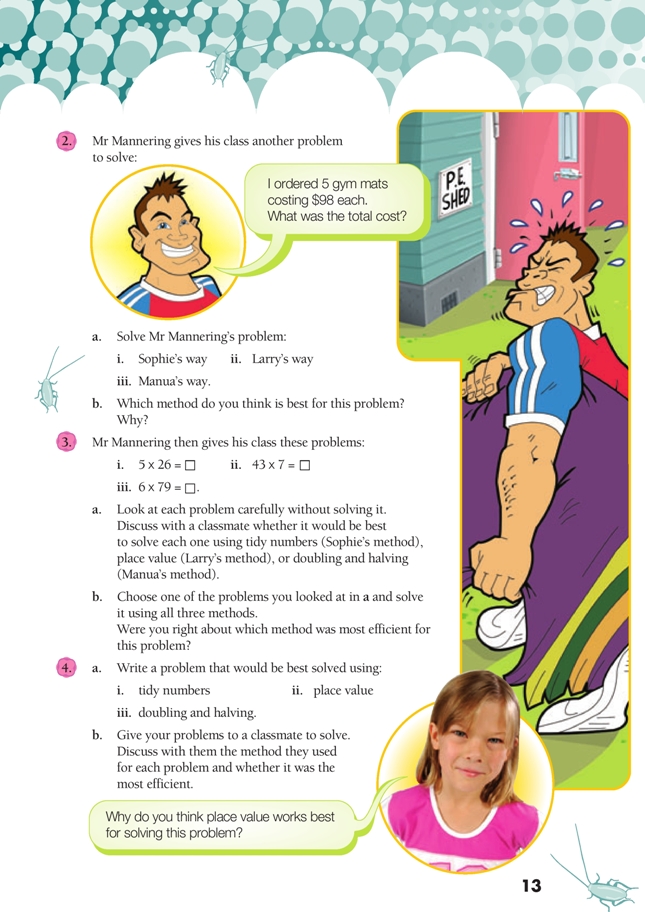This is a level 4 number activity from the Figure It Out series. It relates to Stage 7 of the Number Framework.
A PDF of the student activity is included.
Click on the image to enlarge it. Click again to close. Download PDF (827 KB)
use place value strategies to solve multiplication problems
use tidy numbers strategies to solve multiplication problems
use doubling and halving strategies to solve multiplication problems
Number Framework Links
Use this activity to help students consolidate and compare advanced multiplicative part–whole strategies (stage 7) in the domain of multiplication and division.
A classmate
See the notes for Bean Counters (page 21) on the reasons for students having and using a broad range of multiplicative strategies.
For this activity, students need to be already familiar with the following multiplicative strategies:
• Place value partitioning: partitioning a number (using place value), multiplying the parts separately, and then adding the products.
5 x 48 = (5 x 40) + (5 x 8)
= 200 + 40
= 240
(see Sticking Together, pages 10–11)
• Using tidy numbers and compensating: working out 5 x 50 instead of 5 x 48 because 50 is a tidy number and easy to multiply. But then we have to compensate because we have got 5 groups of 2 more than we need, so we subtract them again.
5 x 48 = (5 x 50) – (5 x 2)
= 250 – 10
= 240
(see Bean Counters, pages 8–9)
• Doubling and halving (making proportional adjustments): doubling one factor and halving the other gives you the same answer and may make the calculation easier.
5 x 48 = 10 x 24
= 240
(see Face the Facts in Multiplicative Thinking, Figure It Out, Levels 2–3, page 6).
This activity is suited to a guided teaching session with a group because there are lots of opportunities for discussion. Introduce the activity by getting your students to solve Mr Mannering’s problem before they look at how the students in the book solve it. Discuss the different strategies your group used and use this discussion as an opportunity to remind the students of the meaning of the terms “place value”, “tidy numbers”, and “doubling and halving”.
The aim of this activity is to help the students learn to make wise decisions about which strategy to use in a particular situation. In order to do this, they need to be able to look at a problem before they solve it and identify features that would prompt them to use one strategy rather than another.
Promote generalisations by asking questions such as:
• Look at the problem before you start working it out; which strategy do you think would be most efficient here?
• What is it about this problem that makes you want to use that strategy?
• List all the problems in the activity and group them according to the strategy you thought was most efficient for each problem. (It may be valid to have some problems in two groups if both strategies are equally efficient for those problems.)
• What do all the problems in each group have in common?
Useful responses will include these ideas:
Doubling and halving: This strategy is useful if it can change the calculation into a known fact or one that is easy to work out, such as 10 times. At least one of the factors should be even so that halving it gives us a whole number.
Tidy numbers and compensating: One of the factors has to be close to a tidy number so there isn’t too much compensating to do.
Place value partitioning: This strategy suits a wide range of problems, but it can be difficult to keep track of if there’s a lot of renaming to do when you’re adding up the parts. It’s easier to use if the digits are small.
Extension
Students could create a flow diagram that shows what they would look for when confronted with a problem and how their strategy decision-making process might progress. They could start by asking “Is the answer to this problem a known fact?” and then ask questions such as “Is the problem 5 times or 50 times something?” If the answer is yes, “Use doubling and halving to create a 10 times or 100 times problem and solve it”; if the answer is no, “Would doubling and halving the problem turn it into a known fact?” and so on.
Answers to Activities
1. a. i. Manua
ii. Sophie
iii. Larry
b. Answers may vary. Manua’s method involved the simplest calculations and was very efficient in this case.
2. a. i. (5 x 100) – (5 x 2) = 500 – 10 = 490
ii. (5 x 90) + (5 x 8) = 450 + 40 = 490
iii. 5 x 98 = 10 x 49 = 490
b. Answers may vary. Sophie’s method involved the simplest calculations and was very efficient.
3. a. Discussion and choice of methods will vary.
i. This would be a good problem for using doubling and halving, because doubling
5 times makes it into 10 times, which is easy to calculate, and the other factor
is an even number, which is easy to divide. The other two methods would
also work well but involve slightly more calculations (using tidy numbers and
place value).
ii. This would be a good problem for using place value to break up the 43. Using
tidy numbers is also possible, but 43 is not very close to a tidy number so the
calculation is a little harder. Doubling and halving is not useful in this case:
both numbers are odd, so it doesn’t help to halve one of them.
iii. This would be a good problem for using tidy numbers because the 79 is very
close to a tidy number. Doubling and halving won’t help. 79 could be broken
up using place value, but the calculations will be more difficult than calculations
using a tidy number.
b. Discussion about the most efficient method will vary. Possible working for each problem is:
i. Tidy numbers
5 x 26 =
5 x 26 = (5 x 30) – (5 x 4)
= 150 – 20
= 130
Place value
5 x 26 = (5 x 20) + (5 x 6)
= 100 + 30
= 130
Doubling and halving
5 x 26 = 10 x 13
= 130
ii. Tidy numbers
43 x 7 =
43 x 7 = (50 x 7) – (7 x 7)
= 350 – 49
= 301
Place value
43 x 7 = (40 x 7) + (3 x 7)
= 280 + 21
= 301
Doubling and halving
43 x 7 = 86 x 3.5 = 301 or 21.5 x 14 = 301 so 43 x 7 = 301. (In both cases, this
strategy makes the calculation harder, not easier.)
iii. Tidy numbers
6 x 79 =
6 x 79 = (6 x 80) – (6 x 1)
= 480 – 6
= 474
Place value
6 x 79 = (6 x 70) + (6 x 9)
= 420 + 54
= 474
Doubling and halving
6 x 79 = 12 x 39.5
= 474
(This strategy makes the calculation harder, not easier.)
4. a. Problems will vary.
i. The problem should have one number that is close to a tidy number to make
it easy to solve.
ii. This strategy suits many problems, but it’s the easiest to use if one number in the
problem is a single-digit number and there isn’t much renaming involved.
iii. This strategy suits 5 times or 50 times problems because these numbers double
to make 10 times or 100 times, which are easy to calculate with. Other problems suit
this strategy if they can be changed into known facts, for example:
4 x 16 = 8 x 8 = 64.
b. Practical activity. See points in 4a.

